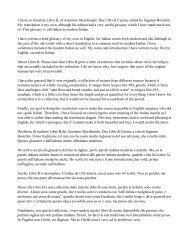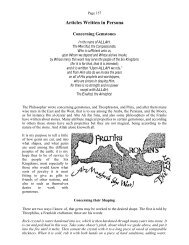How to Milk an Almond Stuff an Egg And Armor a Turnip A ...
How to Milk an Almond Stuff an Egg And Armor a Turnip A ...
How to Milk an Almond Stuff an Egg And Armor a Turnip A ...
Create successful ePaper yourself
Turn your PDF publications into a flip-book with our unique Google optimized e-Paper software.
13<br />
Caboges<br />
Two Fifteenth Century p. 6 (Good–<strong>an</strong>d easy)<br />
Take fayre caboges, <strong>an</strong> cutte hem, <strong>an</strong> pike<br />
hem clene <strong>an</strong>d clene washe hem, <strong>an</strong> parboyle hem<br />
in fayre water, <strong>an</strong> th<strong>an</strong>ne presse hem on a fayre<br />
bord; <strong>an</strong> th<strong>an</strong> choppe hem, <strong>an</strong>d caste hem in a<br />
fayre pot with goode fresshe broth, <strong>an</strong> wyth merybonys,<br />
<strong>an</strong>d let it boyle: th<strong>an</strong>ne grate fayre brede<br />
<strong>an</strong>d caste ther-<strong>to</strong>, <strong>an</strong> caste ther-<strong>to</strong> Safron <strong>an</strong> salt;<br />
or ellys take gode grwel y-mad of freys flesshe, ydraw<br />
thorw a straynour, <strong>an</strong>d caste ther-<strong>to</strong>. An<br />
wh<strong>an</strong> thou seruyst yt inne, knocke owt the marw<br />
of the bonys, <strong>an</strong> ley the marwe ij gobettys or iij in<br />
a dysshe, as the semyth best, <strong>an</strong>d serue forth.<br />
1 medium head cabbage 6 threads saffron<br />
4 c beef broth 1 T salt<br />
4 lb marrow bones ~ 2 c breadcrumbs<br />
Wash cabbage. Cut it in fourths. Parboil it<br />
(i.e. dump in<strong>to</strong> boiling water, leave there a<br />
few minutes). Drain. Chop. Squeeze out the<br />
water. Put it in a pot with beef broth <strong>an</strong>d<br />
marrow bones. Simmer until soft, stirring<br />
often enough <strong>to</strong> keep it from sticking (about<br />
20 minutes). Add saffron, salt, enough bread<br />
crumbs <strong>to</strong> make it very thick. Simmer ten<br />
minutes more. Serve.<br />
Cress in Lent with <strong>Milk</strong> of <strong>Almond</strong>s<br />
Menagier p. M14<br />
Take your cress <strong>an</strong>d parboil it with a h<strong>an</strong>dful<br />
of chopped beet leaves, <strong>an</strong>d fry them in oil, then<br />
put <strong>to</strong> boil in milk of almonds; <strong>an</strong>d when it is not<br />
Lent, fry in lard <strong>an</strong>d butter until cooked, then<br />
moisten with meat s<strong>to</strong>ck; or with cheese, <strong>an</strong>d<br />
adjust it carefully, for it will brown. Anyway, if<br />
you add parsley, it does not have <strong>to</strong> be bl<strong>an</strong>ched.<br />
Lenten version<br />
2 c cress = ⅓ lb ½ c almond milk (p. 7)<br />
½ c beet leaves ¼ c parsley = ½ oz<br />
1 T olive oil pinch salt<br />
Fish-day version<br />
2 ¼ c cress = 6 oz 1 ½ oz brick cheese<br />
1 ½ c beet leaves [3 sprigs parsley]<br />
2 T butter [⅛ t salt]<br />
Meat-day version<br />
2 ¼ c cress = 6 oz ½ c meat s<strong>to</strong>ck<br />
1 ½ c (2 oz) beet leaves [3 sprigs parsley]<br />
2 T lard <strong>an</strong>d/or butter [⅛ t salt]<br />
Chop the cress <strong>an</strong>d beet leaves. Dump<br />
them in<strong>to</strong> boiling water, let the water come<br />
back <strong>to</strong> a boil, then drain them (about 2<br />
minutes <strong>to</strong>tal in water). Heat oil or lard or<br />
butter in a skillet, add drained greens (<strong>an</strong>d<br />
chopped parsley if you are using parsley). Stir<br />
fry for about 3 minutes. For Lenten version,<br />
add almond milk, let boil with greens about a<br />
minute. For fish-day version, add cheese,<br />
chopped up, <strong>an</strong>d stir until cheese is melted<br />
in<strong>to</strong> the greens. For meat-day version, add<br />
meat s<strong>to</strong>ck <strong>an</strong>d cook down 2-3 minutes. Add<br />
salt, serve.<br />
Notes: Measure greens pressed down in the<br />
measuring cup. Use a mild cheese such as<br />
brick cheese. Substitute spinach for beet<br />
leaves if necessary; the Menagier regards<br />
spinach as a kind of beet leaf. We have tried<br />
several ratios of cress <strong>to</strong> beet leaves; all seem<br />
<strong>to</strong> work reasonably well.<br />
Lenten Foyles<br />
Ordin<strong>an</strong>ce of Potage p. 38 (no. 9)<br />
Take the same m<strong>an</strong>er of herbes as thu dost <strong>to</strong><br />
jowtys, <strong>an</strong>d onyons clene paryd. Perboyle hem;<br />
presse out the watyr. Do hem yn a potte. Frye<br />
reysons in clere oyle that have be fryed yn before,<br />
<strong>an</strong>d do ther<strong>to</strong> with a perty of the oyle, <strong>an</strong>d boyle<br />
hit up with the mylke of almondys; <strong>an</strong>d put<br />
ther<strong>to</strong> sugure & salte.<br />
Note: “jowtys” is <strong>an</strong>other recipe for<br />
cooked greens; the one in this cookbook calls<br />
for “kawlys [cabbage-type vegetables] &<br />
percellye <strong>an</strong>d othir good herbes.”





